Faculty Profile, People
Smart Structurist
March 22, 2021

About
Name
Shahria Alam
Role
Professor
Program
School of Engineering
Faculty
Applied Science
Campus
Okanagan (Kelowna, BC)
Education
PhD, Civil & Environmental Engineering, University of Western Ontario
Master of Science, Civil Engineering, Bangladesh University of Engineering & Technology
Bachelor of Science, Civil Engineering, Bangladesh University of Engineering & Technology
Hometown
Dhaka, Bangladesh
“There are enormous opportunities awaiting our students to contribute to building a better world.”
GROWING UP IN BANGLADESH, DR. SHAHRIA ALAM and his family feared earthquakes, which had the potential to level buildings, displace residents and cause fatalities.
So, from a young age, Dr. Alam started asking questions: “Why can’t we come up with a solution that ensures buildings don’t collapse? Or devise systems to keep buildings from being torn down and rebuilt because of their lack of resiliency?” He explains, “this made me think a lot about how structures were designed, and with what materials.”
Fast-forward more than 20 years and Dr. Alam is now a civil engineering professor at UBC Okanagan’s School of Engineering and a Tier 1 Principal’s Research Chair (PRC) of Resilient and Green Infrastructure. In this role, Dr. Alam provides global leadership in developing resilient, green infrastructure components and systems that can survive multiple hazards. He is developing novel, sustainable materials as well as contributing to advancing research that will safeguard aging and new infrastructure.
“We live in a world where urbanization and climate change are conflicting with one another, and causing many challenges,” Dr. Alam says. “Those challenges include increasing waste in landfills and crumbling infrastructure.
“Not to exaggerate the situation, but it feels like we’re at a precipice for humanity where we need to start incorporating innovations like smart technologies to address some of these challenges.”
Through funding from the Canada Foundation for Innovation, Dr. Alam established the first smart structures lab in Canada: the Applied Laboratory for Advanced Materials and Structures. Alongside his research team, Dr. Alam uses advanced materials to develop smart structures which can sense external stimuli like pressure, velocity or temperature changes and then respond in a real time controlled manner.
A prime example of their work is a smart bracing system formed using shape memory alloys and friction springs. Together these additions augment the sustainability of existing and new buildings and structures by self-centring the infrastructure during earthquakes.
“Smart cities are a big theme in civil engineering these days. Our research is leading towards many innovations in projects like the smart bracing system and rocking steel bridge pier, but also the development of sustainable construction materials like green concrete,” explains Dr. Alam, whose research group is also developing alternatives to make conventional concrete more sustainable. Currently, conventional concrete uses cement, sand and gravel as aggregate within the mixture, but Dr. Alam is testing the use of by-products such as wood ash from timber industries, granulated concrete from landfills and shredded tires as partial alternatives to cement and aggregate.
“There isn’t one single solution that will address these big issues, but by using them like building blocks, we’ll start to make a genuine impact on the world around us.”
Prior to joining UBC Okanagan, Dr. Alam worked as a structural engineer on large-scale projects such as the Canadian Museum for Human Rights, Las Vegas’ CityCenter building and the Burlington Performing Arts Centre. “When I was in industry, there were only a handful of voices calling for more sustainable and resilient solutions. But that’s really shifted over the last decade or so.”
Now, Dr. Alam seeks to empower his industrial collaborators and the construction sector to build structures with locally-available materials that can be the foundation of resilient infrastructures. Through the Green Construction Research and Training Centre — a partnership between UBCO, Okanagan College and community and industry stakeholders — Dr. Alam is helping to provide new research options and create hands-on practical training opportunities for students.
“There’s a desire from the public, industry, community leaders and researchers to create civil infrastructure that is safe, durable, energy-efficient and affordable through innovative technologies,” he explains. “We’re making in-roads towards real change.”
When he thinks back to his childhood, Dr. Alam smiles, knowing that his research will make it safer for children in his boyhood neighbourhood and those around the world.
“There are enormous opportunities awaiting our students to contribute to building a better world.”